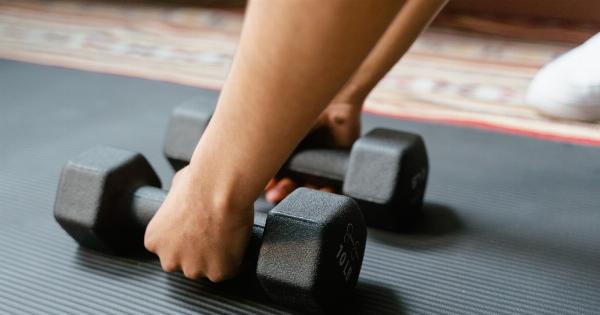Life is full of ups and downs, and it’s natural to experience stress and sadness at times. However, letting these negative emotions take over your life can be detrimental to your overall well-being.
Fortunately, there is a simple and effective solution available to everyone – exercise. Regular physical activity not only benefits your physical health but also plays a significant role in improving your mental and emotional well-being.
In this article, we will explore how exercise can transform your life by helping you release stress and sadness.
The Connection Between Exercise and Mental Health
It is no secret that exercise has numerous benefits for your body, from improving cardiovascular health to increasing strength and flexibility. However, many people are unaware of the powerful impact exercise can have on mental health.
Engaging in regular physical activity stimulates various brain chemicals, such as endorphins, dopamine, and serotonin, which are known to elevate mood and reduce stress. These natural chemicals function as neurotransmitters, allowing communication between nerve cells in the brain.
Endorphins, often referred to as “feel-good” hormones, are released during exercise and produce a sense of euphoria and general well-being. Dopamine, another neurotransmitter linked to exercise, is responsible for motivation and reward.
Regular exercise can increase dopamine production, which can lead to improved mood and motivation in all areas of life. Serotonin, known as the “happiness hormone,” is released during exercise and helps regulate sleep, appetite, and mood.
By incorporating exercise into your daily routine, you can increase the levels of these brain chemicals and their positive effects on your mental health.
This can help alleviate the symptoms of stress and sadness, leading to a happier and more fulfilling life.
The Stress-Relieving Power of Exercise
Stress is a common response to the demands and pressures of everyday life. While some stress can be beneficial, chronic stress can be detrimental to both your physical and mental health.
Engaging in regular physical activity is one of the most effective ways to combat stress and its negative effects on your well-being.
When you exercise, your body releases tension and built-up energy. Physical activity serves as a natural stress reliever, reducing the production of stress hormones, such as cortisol, and promoting relaxation.
It helps channel your focus away from the stressors in your life and redirects it towards the movements and sensations of your body. This shift in focus allows you to temporarily escape from the overwhelming thoughts and worries that contribute to stress.
Furthermore, exercise can act as a form of meditation in motion. It provides a temporary reprieve from the constant mental chatter, giving your mind a break.
As you engage in physical activity, you become immersed in the present moment, allowing you to let go of past regrets and future anxieties. This mindfulness can help you gain a fresh perspective, reduce stress levels, and enhance overall well-being.
Types of Exercise to Release Stress and Sadness
When it comes to stress and sadness, not all types of exercise are created equal. While any form of physical activity can be beneficial, certain exercises have been found to have a more profound impact on mental health.
Here are some types of exercise that can help you release stress and sadness:.
1. Cardiovascular Exercise
Cardiovascular exercises, also known as aerobic exercises, increase your heart rate and breathing for an extended period. These activities include brisk walking, running, cycling, swimming, dancing, and aerobics.
Cardiovascular exercise stimulates the production of endorphins, enhancing mood and reducing stress. Aim for at least 150 minutes of moderate-intensity cardiovascular exercise each week for optimal mental health benefits.
2. Yoga and Pilates
Yoga and Pilates are mind-body exercises that combine physical movement with deep breathing and mindfulness. These practices promote flexibility, strength, and balance while also calming the mind and reducing stress.
Regular yoga and Pilates sessions can help release tension held in the body, relieve anxiety, and improve overall mental well-being. Consider joining a class or following online tutorials to incorporate these exercises into your routine.
3. Strength Training
Strength training involves using resistance, such as weights or bodyweight exercises, to build and tone muscles. While it may seem unrelated to releasing stress and sadness, strength training offers numerous mental health benefits.
Not only does it boost self-confidence and improve body image, but it also promotes the release of endorphins and improves overall mood. Incorporate strength training exercises into your routine two to three times a week to experience these mental health benefits.
4. Mindful Walking or Jogging
Walking or jogging can be transformed into a mindful exercise by focusing on each step, breath, and the surrounding environment.
By engaging your senses and redirecting your attention to the present, you can turn a simple walk or jog into a powerful stress-relieving activity. Leave your distractions behind, embrace the moment, and let the rhythmic movement guide you towards a calmer state of mind.
5. Dancing
Letting loose and dancing to your favorite tunes has significant benefits for releasing stress and sadness. Dancing is a fun and dynamic activity that allows you to express yourself while moving to the rhythm.
It increases your heart rate, promotes the release of endorphins, and helps you focus on the joy of movement. Attend dance classes or create your own dance routine at home to enjoy the mental and emotional rewards.
Remember, the type of exercise you choose is not as important as finding something you enjoy and can incorporate into your routine consistently.
Aim for a combination of cardiovascular exercise, strength training, and mind-body exercises to reap the maximum mental health benefits.
Creating a Sustainable Exercise Routine
To harness the transformative power of exercise, it is essential to create a sustainable routine that fits your lifestyle. Here are some tips to help you establish and maintain a regular exercise habit:.
1. Set Realistic Goals
Start by setting realistic and achievable goals. It’s better to begin with small, attainable goals rather than overwhelming yourself with unrealistic expectations.
Gradually increase the intensity, duration, or frequency of your exercise sessions as you progress.
2. Find Activities You Enjoy
Identify activities you genuinely enjoy to increase your chances of sticking to your routine. Experiment with different exercises until you find something that keeps you engaged and motivated.
Whether it’s cycling, swimming, dancing, or playing a team sport, the key is to have fun while moving your body.
3. Schedule Exercise as a Priority
Make exercise a non-negotiable part of your daily schedule by prioritizing it like any other important task. Set aside specific times for physical activity and treat them as sacred appointments with yourself.
Consistency is key in reaping the long-term benefits of exercise.
4. Mix Up Your Routine
Avoid boredom and prevent exercise burnout by regularly mixing up your exercise routine. Try new activities, explore different routes for your walks or jogs, or join group classes to add variety to your workouts.
This will keep your mind engaged and allow you to discover new ways to enjoy physical activity.
5. Seek Support
Enlist the support of family, friends, or a workout buddy to help you stay motivated and accountable. You can exercise together, share your progress, or even join organized fitness groups.
Having a support system can make the journey more enjoyable and increase your commitment to regular exercise.
Finding Balance in Your Life
While exercise can be a powerful tool for transforming your life, it is essential to find balance in all areas of your life.
In addition to regular physical activity, prioritize other self-care practices such as getting enough sleep, nourishing your body with healthy food, maintaining social connections, and engaging in activities that bring you joy.
Remember, everyone’s journey is unique, and it might take time to fully integrate exercise into your life and experience its transformative effects.
Be patient with yourself, celebrate small victories along the way, and embrace the positive changes that will gradually unfold as you exercise your stress and sadness away.































